Elevation Passing for Normal
New in Ceasefire, Passing for Normal - Posted on Sunday, August 15, 2021 18:56 - 1 Comment

“There is a part of everything that is unexplored”
— Gustave Flaubert
Over several months during lockdown, I became increasingly aware of an urge to be able to see over the hedge of my back garden and across to the hills behind.
Finally, I felt moved to pursue this urge, as part of an ongoing campaign to listen to half-formed gut instincts. We don’t have much of a vocabulary in English in relation to the ‘gut brain’. Some people use the phrase the ‘enteric nervous system’ but – inexplicably – the phrase hasn’t caught on.
The following visual metaphor helps me remind myself to listen to my stomach:
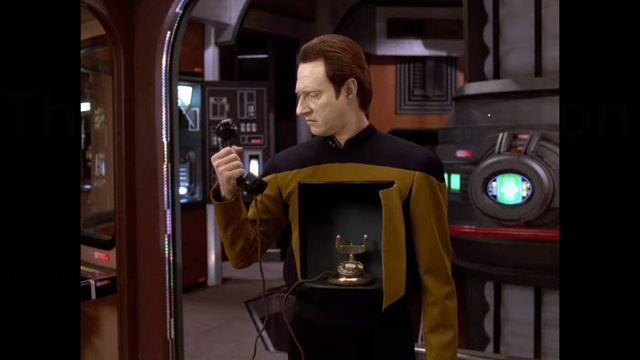
But enough context. If I keep going down this line, I will end up at the beginning of the (current) universe.
I had two options for being able to see the hills beyond my hedge. The first was to chop the hedge down. This quickly turned out not to be an option after all. The second option was to raise myself up in or near the big tree in my garden. Being in or near the tree would provide shelter and discretion. I began to investigate the concept of an elevated chair.
One of the most common types of elevated chairs is the tennis umpire chair. A nice option because they are wooden and blend in with a tree. But they are expensive and, anyway, I could not figure out how to reasonably transport one from a tennis court to my house. Also, it seemed to be that the primary function of the elevation in this type of chair is to pronounce judgement on those below. It draws on the fact that people below you feel a little bit more inclined to listen to you. It is, in some ways, an elevated throne. “This person is in charge”, is what this chair says to those below. That wasn’t the vibe I was after.
Next I considered lifeguard chairs. I have spent many hours sitting in them because I used to be a lifeguard. So they are reasonably comfortable, but they don’t look so nice when positioned next to a tree. The primary function of elevation in this chair is to provide a sense of safety for those below. ‘This person will look after you’, is what this chair says to them. A pleasant vibe, but a misleading one in this context.
An astronomy highchair was a new discovery for me during those early months of my enquiry. It’s a type of chair where you can move the seat up and down according to the angle of, I guess, your telescope or the stars you’re looking at. The adjustable height was a nice feature. Only problem for me, even at the highest setting, an astronomy chair was never going to be high enough to let me see over the hedge. Stars and planets, no problem. Over the hedge, no way. The primary function of elevation in this chair is observation of what is above. “This person is on a different planet”, is what this chair says to those below. An unsettling vibe to convey.
So much for astronomy observation seats. But perhaps I was looking in the wrong direction: perhaps I needed to look down in order to look up? Perhaps I needed a baby’s highchair? The obvious problem was that a standard baby’s highchair was never going to work for me as a fully-grown adult male. The optics would be all wrong. The primary function of elevation in this type of chair is to provide access to that which is otherwise inaccessible, and thus was closest in spirit to what I was after. “This person is not yet fully grown”, is what this chair says to those below. I quite liked the concept of improved accessibility but could do nothing with the idea since a ‘high’ chair was, in actual fact, far too low for my situation.
For all the reasons set out above, and others I’ve left mercifully unmentioned, none of these chairs suited me. I extended my search to the world of art, and happily discovered lots of different uses of elevated chairs. For example, the idea behind this elevated chair below, from an artist called Angie Hiesl, is to make more visible people in society who are usually invisible:
The primary purpose of elevation for this chair is to provide social commentary about how older people are treated in a society. “This person deserves greater respect”, is what this chair says to the people below.
I like the chair in this picture for very many reasons, but was not interested in the idea of making myself more visible – I’m plenty visible enough, thank you Angie! – and, besides, I was distracted by logistical questions such as: how was the chair attached to the wall? How did the person get up there? Did the person definitely want to be up there? Had they changed their mind? Therefore, the chair didn’t help me with my immediate purpose, although it prompted a still-unfulfilled urge to look into different uses of giant furniture in art installations.
Inspired by Hiesl’s work, I discovered other art installations featuring elevated chairs, many providing an element of surrealism that rang the invisible telephone in my gut. But I was no closer to finding an actual chair that might actually work in my actual garden.
Moving on from the world of art, I started to see elevated chair-type structures wherever I went. Travelling on a train I spotted the structure in the photo below, which I immediately wanted to take home with me, but of course the train was in motion:
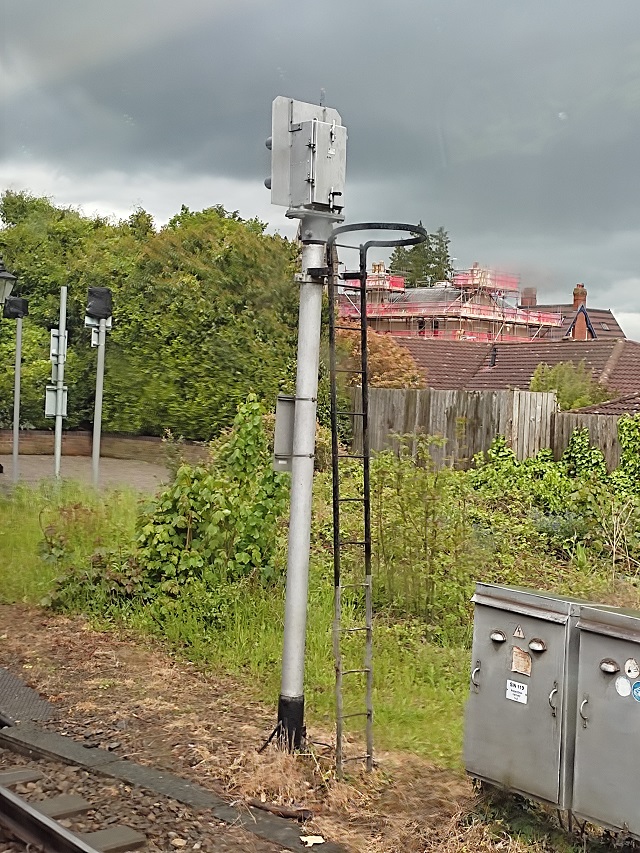
Am I the only person who ever looked at this structure and thought “with a cushion incorporated into the round bit on top, this would make a nice place to sit”? Probably. Does that matter? Probably not.
Another time I saw this cherry picker, and for a while played with the idea that what I really needed was a mobile elevated seat on wheels:

But even leaving aside the fact that I lacked the disposable income for such a machine, there was no way I could get something of that size into my back garden without demolishing part of the hedge. And if I did that, I wouldn’t need the cherry picker because the view would be clear.
Sharing my dilemma with a practical friend, I was advised to visit a shop in my local town that sells ‘high quality tat’. I asked the proprietor, Becky, to see if she stocked any elevated chairs of any description. The most elevated chair she had in stock was a bar stool.
It struck me that the purpose, and implied message, of a bar stool is actually quite similar to that of a baby chair: namely, providing access to that which is otherwise inaccessible. It was a nice bar stool but, as with the baby chair, it would not be high enough to enable me to see over the hedge.
Becky then mentioned something called a ‘hanging egg chair’, which could be suspended from different heights. An important and exciting suggestion, which among other things made me more confident in my assumption that there did exist, somewhere in the world, a chair that would meet my exact needs.
And so I discovered a line of chairs which were available from a well-known discount supermarket, but which had rapidly sold out during lockdown. It seemed like Covid had really brought out in others, too, a strong urge to want to sit in or near trees.
Still, the hanging egg chair looked promising, and confirmed the idea of using the tree as part of the structure, rather than being free-standing as I had imagined it up to that point. It seemed to me that the primary purpose of elevation for this chair is to provide suspension from gravity, to enable the chair’s inhabitant to move somewhat freely around in three dimensions. “This person is in mid-air”, is what this chair says to the people below.
I was still thinking about hanging egg chairs when I spotted my daughter inadvertently recreating one half of Magritte’s painting ‘The Lovers’, using a chair hammock, and the thought occurred to me, Oh my God, what if I already have everything I need to create my own hanging egg chair? What, in other words, if the thing I most needed had quite literally been right in front of me all along?
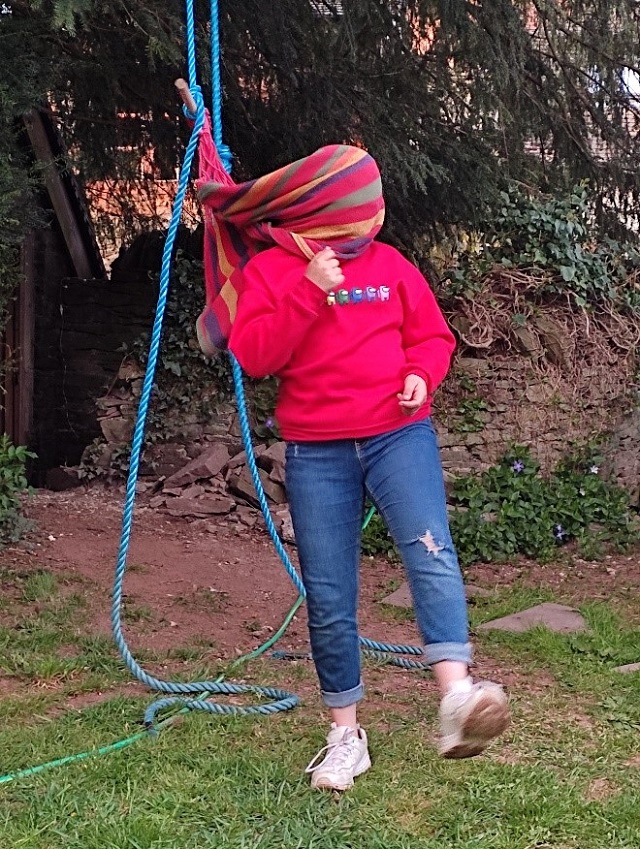
I waited for my daughter to finish her surrealist re-enactment and elevated the chair hammock way up high in the tree, so that it would enable me to see over the hedge, to the hills beyond.

It seemed to offer all the anti-gravity attraction of the hanging egg chair without any of the online queuing hassle, but in my excitement I had forgotten about the fundamental drawback of the non-anchored chair, which was that there was no way to get in or out of the chair without risking serious injury.
I considered investing in a crash mat or a safety net, but decided against it on the basis that no chair should have to come with its own crash mat. I lowered the chair hammock back to its original elevation, a couple of inches off the floor, to the relief of the family, and came to terms with the fact that I had moved precisely no closer to my target.
Sometime later I was talking to a friend, who lives on a different hill, about my fruitless chair quest. He mentioned that, in the woods near him, he had seen a type of elevated chair which hunting folk strap to trees and sit in so they can shoot at birds and other animals without being spotted. He said it in a matter-of-fact way, like, “Everyone knows these are a thing, what’s wrong with you?” I began looking into ‘shooting chairs’ and ‘hunting chairs’, but neither seemed to be the right term. Was this definitely a thing or had my friend been taking hallucinogenic drugs while walking in the woods?
Then I tried looking for high seats. Stalking high seats, to be precise. A place for, I guess, mostly men to hide themselves up a tree while waiting for birds and animals to kill. The primary purpose of elevation in this instance is to provide camouflage. “There is no person up that tree”, is what the chair says to the unsuspecting prey below. But what if you sat in the chair and didn’t shoot at animals and birds? Well, here was surely an actionable idea. The right-wing gun lobby had already solved the problem that had been presenting itself to me for such a long time. The lesson was clear.
I found a company called ‘Keith’s High Seats’. The idea of such a literal, does-what-it-says-on-the-tin company name profoundly appealed to me. It made me wish that, back when I worked as a freelancer, I’d had the guts to call my business: ‘Dave’s consulting’. But Keith offered premium models, designed for the serious shooter.
After a while I found the closest thing I could get to a budget stalking high seat, not wanting to cut too many corners on the cost of something that was going to support me while halfway up a tree.
There followed a period of internal wrestling with my conscience about whether or not it was, all things considered, appropriate to invest one hundred actual monetary pounds on what appeared to be a fundamentally non-essential item. I sat on the decision for several days, wasting money on things like takeaway food and drink, realised I still wanted it, though not really able to explain why, and made the purchase.
A short while later, a stalking chair arrived in a flat pack. Assembly occurred, minus the cross-piece to lean a gun on. I then strapped the whole thing to the very old yew tree in my back garden. At one point during the ratchet-strapping operation, I had to stray onto my neighbour’s driveway to get the strap all the way around the tree. As I crashed around in the undergrowth, my neighbour came out to ask what I was doing. I hesitated, wondering how far to go back in the story, before settling on explaining what I was doing and leaving out the why I was doing it, a question I could only answer once I sat up the tree.
Then it was ready. I climbed up the disturbingly high ladder and, for the first time, sat 3.5 metres above my garden.
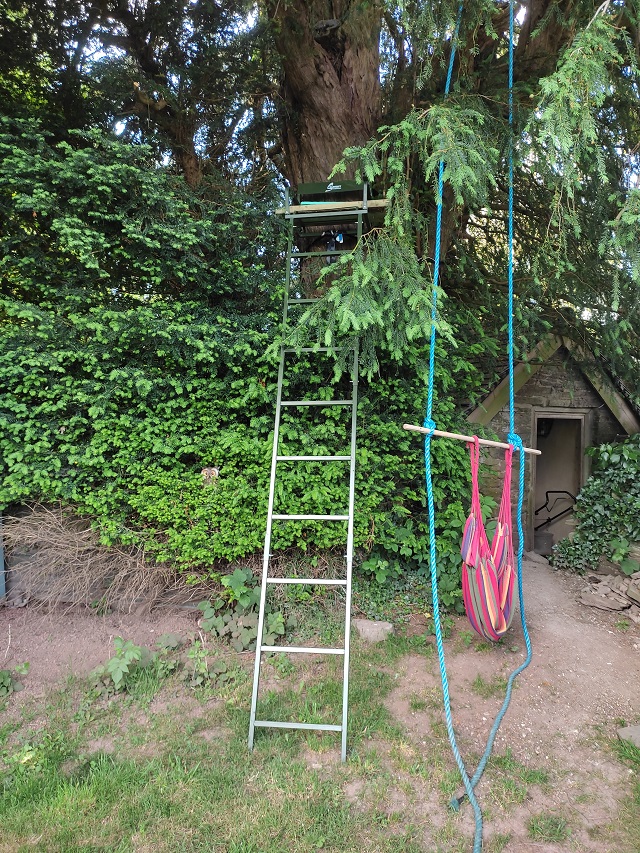
The view out to the hills beyond was mostly obscured by branches, but it didn’t matter: at least I could see over the hedge. More importantly, leaning my head back against the trunk of the centuries-old tree conveyed a particular and unusual psychological flavour, which my stomach seemed to appreciate. And I was level with wood pigeons and blackbirds who, I liked to think, accepted me as one of their own.
The primary purpose of elevation for my chair, I realised, was to enable metamorphosis. “This person is a bird”, is what the chair says to the people below.
POSTSCRIPT
During the course of my research, which ended on such a deeply, strangely satisfactory note, I had compiled possibly the most comprehensive and defiantly useless list of elevated chairs that has ever been compiled, which I’m pleased to share in Figure 1, below.
Figure 1: Types of elevated chair, by frequency
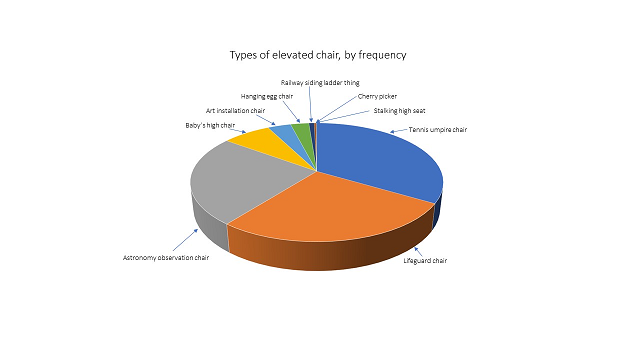
1 Comment
Jams O'Donnell



Nice story, Dave, in the best tradition of Baron Munchausen. I enjoyed it. More?